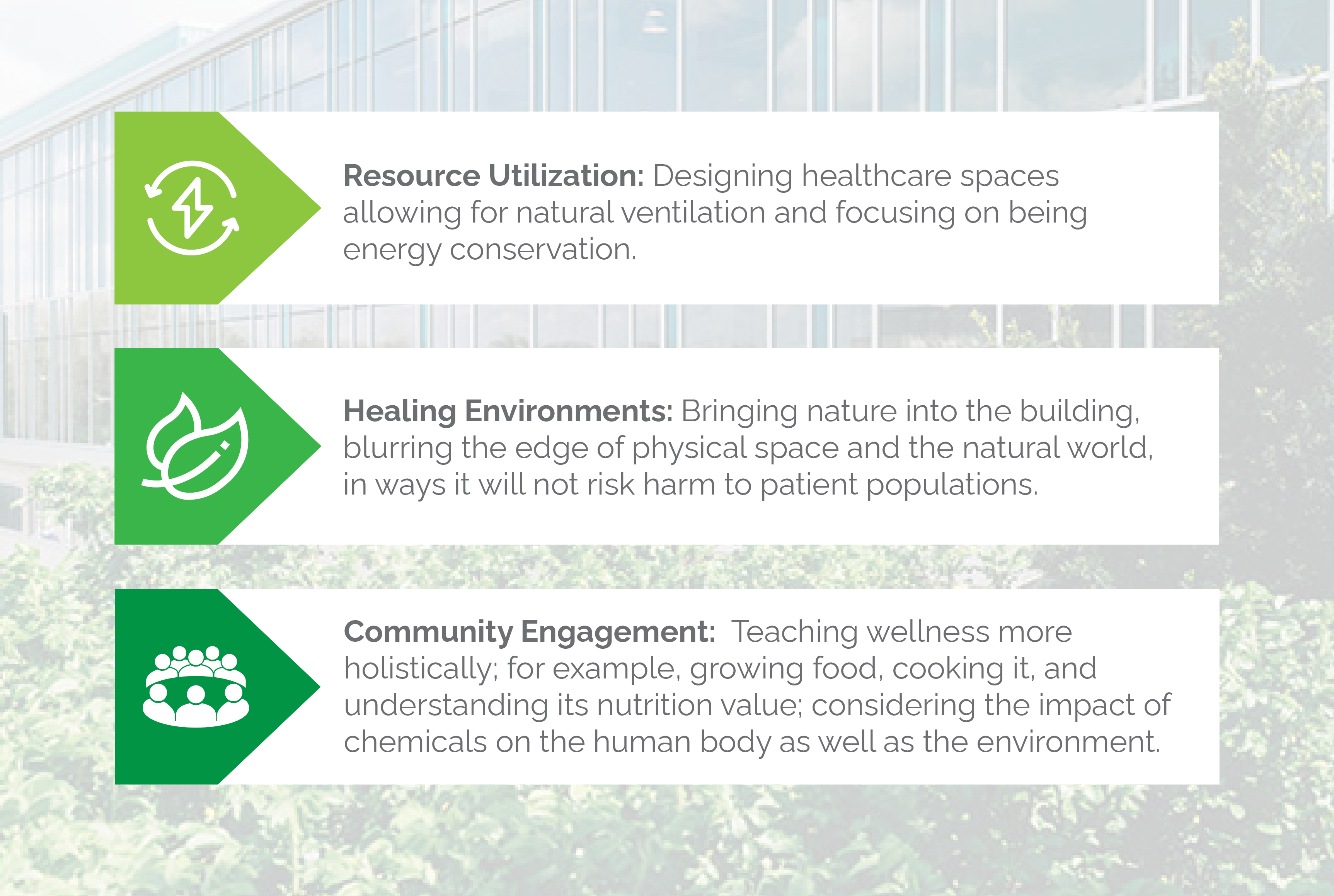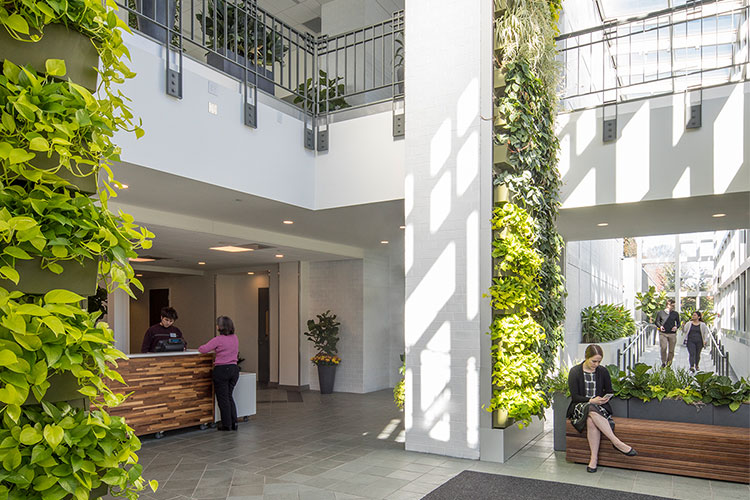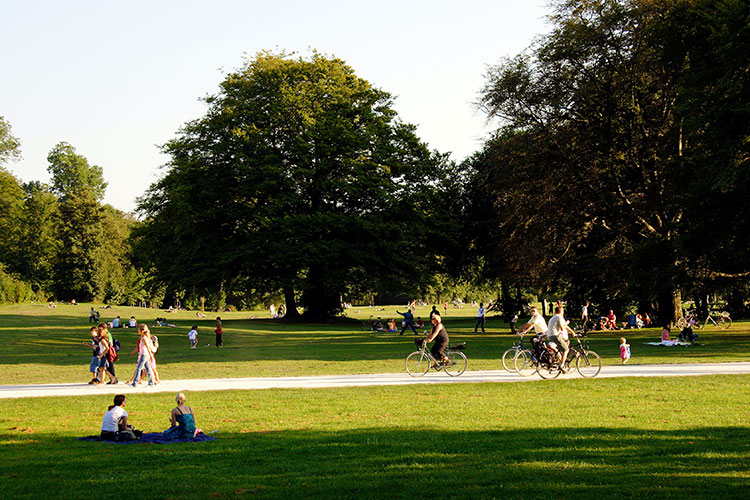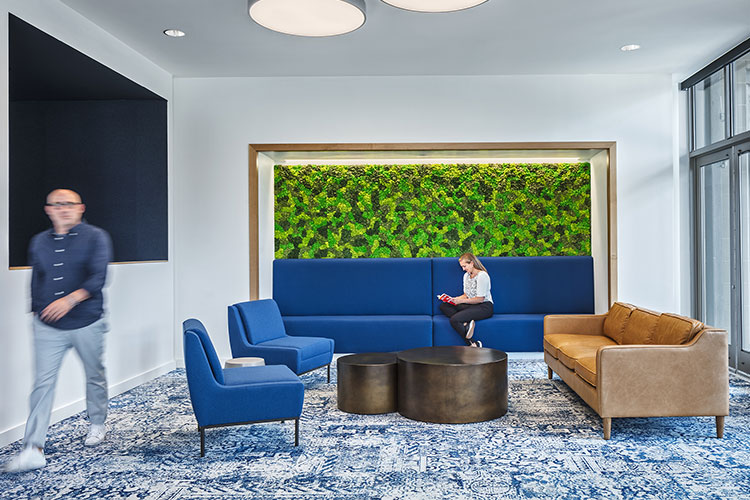It’s easy to add superficial nature elements to design, indoors and out. Environmental psychologist Dr. Judith Heerwagen advocates for thinking about it much more deeply. DesignGroup’s Chris Haedt spoke with her about biophilic design and how architecture can be improved through an evolutionary, biological perspective.
By: Chris Haedt, AIA, NCARB, LEED AP BD+C // Associate Principal, Designer
Healthcare institutions have a responsibility to be social and environmental leaders. To do this, there needs to be a bigger idea that helps guide this rallying cry. I believe the natural world can be that driver. It can anchor the thinking in a bigger-picture context of healthy living through connection to the natural world.
Within that environment, hospitals can focus on three areas:

To be resilient in healthcare, we truly need to consider biophilic principles into design. This concept aligns with the Hippocratic Oath and the very reason for medicine: Primum non nocere – first do no harm. And it can seat these institutions as the bedrock of their communities.
To help illustrate this, we contacted industry thought leader Dr. Judith Heerwagen. Judith’s background in ecology and biology has enhanced her work in studying the psychology of why humans behave the way they do. She strongly advocates for biophilic design, the integration of nature and built environments. After all, the natural world has been part of our genetic make up for millions of years. Driving it out of places as important as hospitals is simply counterintuitive.
We spoke with Judith from her home office in Seattle, where smoke from the Oregon wildfires had drifted into her area and created haze and breathing difficulty, a situation she described as grim. Our conversation, fortunately, was much more optimistic.

DesignGroup: Do we, as humans, need interaction with nature?
Judith Heerwagen: The truth is, people can survive without it. The better question is, perhaps, what helps people thrive? We lived in the natural environment for millions of years. The built environment is very young in comparison. We have adapted, for our survival, to recognize the parts of nature that are helpful and those that are harmful. We’ve seen the harmful side magnified in the recent natural disasters. But we’ve also evolved to seek out the positive sides of nature: flora, fauna, water, and sunlight. There is a strong need ingrained in us to seek out the positive attributes. Satisfying that urge promotes mental and emotional well-being. It helps us to thrive by affiliating with nature.
It is important to note that biophilic design is not a cure all. It is a process of integrating back with nature that we know is beneficial to our emotional and physical well being. Why wouldn’t we do it? We have an innate desire to associate with nature, to satisfy the nature module in our brain. Whether it’s for physical health or our social and emotional well-being, we understand the benefits associated with being connected to the natural environment. Rodger Ulrich’s breakthrough article in the journal Science years ago started a serious, long-lasting assessment of how nature really does help our health. His study showed that hospital patients whose window view was nature-dominant (mainly trees) stayed in the hospital fewer days than those who had a window view without natural elements. The study opened up a whole new way of thinking about hospitals and patients.

How does the natural world impact our health and well-being?
Stress reduction is a really powerful impact, but there's also the experience of more positive moods, which affect our physical and social health as well as our general sense of well-being. These are powerful and consistent results across studies. And we know that many aspects of nature that can elicit these responses.
Flowers are one. There's been some really interesting work done in psychology on this. In one study, researchers would hand a person entering an elevator either a flower, a piece of fruit, or a pen. Two were natural things, the flower and the fruit, then a pen that had nothing to do with nature at all. Researchers studied how people responded to the gift, and only the flower elicited what is called a true smile. You can't fake a true smile, the way it changes your cheeks and your eyes. It was a clever experiment. Another study, by a landscape student of mine, looked at how children play outdoors. She carefully observed young kids at recess in two areas — one a very natural area, the other a more traditional climbing structure. She found that the children attracted to the natural space engaged in much more imaginative play. They would explore the overgrown hedges and pretend they were houses or spaceships — a very different type of play than the children on the playground who would run and jump and climb. Both kinds of play are important to development, but imaginative play is considered extremely valuable to child development. Pretend play enhances their ability to imagine things — a high-value skill, especially in problem solving. We’re an imaginative species and facilitating that imagination is important.
A final anecdote: when my student went back to the school for her final day of gathering data, she discovered that all of that nature, the hedges and stuff, had been pulled out over the weekend. She asked the staff, "Why did you do this?" And they said that they were concerned because they couldn't see the children. They had no idea whatsoever of the play value of that space.

How can nature be incorporated into the physical healthcare environment to promote healing?
That's a great question and health care is surprisingly behind the curve on this. There are so many opportunities here for looking at how to reimagine the hospital setting — focusing not on getting people over illness but helping them get well in a very positive way. And that includes the doctors, the nurses, the people who work there. This isn't just about patients. It's for the entire population. The visitors as well, because it's a very high-stress environment.
When you walk into a hospital, it often doesn't feel like a place for healing. To begin with, it's colorless. Nothing says “healing” other than the presence of white walls and people in white coats. There's so much possibility. Think about how you treat the spaces surrounding the hospital. If you've got land you can put natural features in. Trees are particularly valuable, and flowers. As you walk toward the hospital it would seem more welcoming, because you see right away that the hospital is in a natural, biological environment.
Medical offices frequently use a fish tank to enhance space, but people often aren't paying any attention to it. They're absorbed with their phones. So how do you actually design the environment in a way that enhances visual engagement and psychological comfort? For instance, how do you begin to use color more effectively? We have color vision, for heaven’s sake.
You can also use nature murals and photographs when you can't put in real plants or other nature elements. Colors like blues and pinks and peaches can really enliven a space. If the only thing you do is color in the furnishings and the walls, that alone can make a big impact. Even if it’s as simple as colored blankets. Our homes aren’t all beige and gray. Color helps make hospitals more home-like.

Have studies been done to validate these ideas?
Yes. In one study of a hospital in England, they added color in different ways and the improvement in patient outcomes was significantly higher than having kept it a neutral palette.
I think it's just wide open for thinking about biophilia as a healing component of a health care setting. Making it more of a people space than shrubbing it up to make the building look good. Water, for example, is inherently soothing to people. Research shows that stress is relieved by the sound of gently flowing water. Water features in the exterior environment are being used to counteract the sounds of traffic. This is one of the natural elements that would be really interesting to integrate more effectively into the hospital environment.
Biophilia is not a fad. That’s the thing that needs to be really understood. We've got some really important research [about] things you can do that aren't going to cost a lot of money. Other solutions are more expensive, but look at the impact on not just patients, but the doctors, nurses, and the people who visit them. Anything you can do to make their lives more pleasant in the hospital, reduce their stress, or improve their emotional functioning, is valuable, because hospitals are stressful. There's a whole slew of people who benefit from this.

How do we ensure that these principles are equitably distributed?
This is a really, really important issue and I’m glad you raised it. It should be equitable. It needs to be democratized. It needs to be looked at as something that’s good for everybody. There are different ways to do this. Some will be policy, some can be design. Recent studies have suggested that, with the advent of the pandemic and working from home, dollars can be saved on real estate by incorporating work-from-home strategies in a more permanent way. Healthcare leaders may be able to shift these dollars long-term so that they can be used to help push healing spaces into communities, especially areas that are currently underserved.
Regardless, we need to think about these things as an ecosystem of connected parts. We tend to put things in boxes, whether it's professions or buildings or neighborhoods. We need to get out of the boxes and think more holistically. That's why I like ecology — it is not in a box. Species aren't in a box. They interact. They interact with the environment and I think it's that sense of an ecosystem, which I always go back to. That's what nature builds on.
Species exist together in a space and they have to get along. They might use the space differently, but it's the same space. My backyard must have 15 species of birds and they all use the environment differently. We need to think like that — a hospital can be an ecosystem.
About the Contributors:

Chris Haedt, AIA, NCARB, LEED AP BD+C // Associate Principal, Designer
With almost 17 years of experience, Chris's passion for design stems from his belief that architecture is part of a larger whole. The physical environment influences how we learn, work, socialize, worship, grieve, and heal. Chris strives for balance; balancing the needs of clients with how the spaces created will fit into the larger societal whole. He is passionate about the opportunity for space to have a positive impact on its inhabitants, especially in healthcare where staff can be steeped in stress and patients are often at their most vulnerable. Chris communicates his progress as he works with healthcare clients to overcome challenges and reach consensus throughout design.

Judith Heerwagen // Environmental Psychologist
Judith Heerwagen is an environmental psychologist whose work focuses on the “goodness of fit” between people and the environments they inhabit, including emotional, social, cognitive, and physical fit. She is currently a Research Psychologist with the US General Services Administration and an affiliate faculty member in Architecture at the University of Washington. Prior to joining GSA she was a senior scientist at the Pacific Northwest National Laboratory and also had her own consulting business for 10 years. She has written and lectured widely on biophilic design and the links between human health and the natural and built environments. She is co-editor of Biophilic Design: The Theory, Science and Practice of Bringing Buildings to Life, which won the 2008 Publishers Award for best book in architecture and urban planning. She received the 2014 Design for Humanity Award from the American Society of Interior Designers for her work in biophilic design and has also served as a special lecturer on biophilic design at Yale University and Louisiana State University.
